
Pseudoscorpions, also known as false scorpions or book scorpions, are small, scorpion-like arachnids belonging to the order Pseudoscorpiones, also known as Pseudoscorpionida or Chelonethida.
Dauer describes an alternative developmental stage of nematode worms, particularly rhabditids including Caenorhabditis elegans, whereby the larva goes into a type of stasis and can survive harsh conditions. Since the entrance of the dauer stage is dependent on environmental cues, it represents a classic and well studied example of polyphenism. The dauer state is given other names in the various types of nematodes such as ‘diapause’ or ‘hypobiosis’, but since the C. elegans nematode has become the most studied nematode, the term ‘dauer stage’ or 'dauer larvae' is becoming universally recognised when referring to this state in other free-living nematodes. The dauer stage is also considered to be equivalent to the infective stage of parasitic nematode larvae.
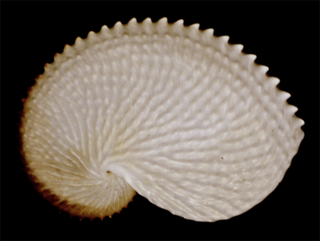
Argonauta nodosus [previously known as Argonauta nodosa], also known as the knobby or knobbed argonaut, is a species of pelagic octopus. The female of the species, like all argonauts, creates a paper-thin eggcase that coils around the octopus much like the way a nautilus lives in its shell. The shell is usually approximately 150 mm in length, although it can exceed 250 mm in exceptional specimens; the world record size is 292.0 mm. A. nodosus produces a very characteristic shell, which is covered in many small nodules on the ridges across the shell, hence the specific epithet nodosus and common name. These nodules are less obvious or even absent in juvenile females, especially those under 5 cm in length. All other argonaut species have smooth ridges across the shell walls.

Protoreaster nodosus, commonly known as the horned sea star or chocolate chip sea star, is a species of sea star found in the warm, shallow waters of the Indo-Pacific region. They are sometimes seen in the marine aquarium trade or dried and sold as curios.
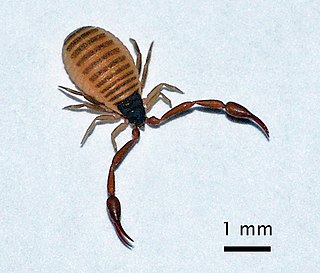
The Cheliferoidea are a superfamily of pseudoscorpions.
Dichelobacter nodosus, formerly Bacteroides nodosus, is a Gram-negative, obligate anaerobe of the family Cardiobacteriaceae. It has polar fimbriae and is the causative agent of ovine foot rot as well as interdigital dermatitis. It is the lone species in the genus Dichelobacter.
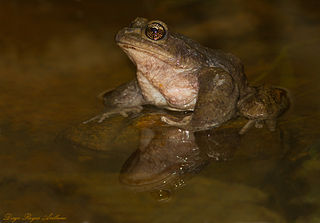
Alsodes nodosus is a species of frog in the family Alsodidae endemic to central Chile; records from Argentina are not considered valid.
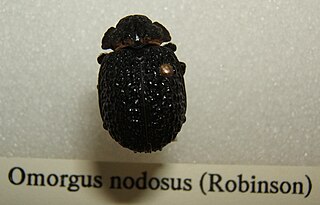
Omorgus nodosus is a beetle of the family Trogidae.

Parasitidae is a family of predatory mites in the order Mesostigmata that has worldwide distribution. They are the only family in the superfamily Parasitoidea. Relatively large for mites, their color is often yellowish to dark brown. The family as a whole preys on a wide variety of microarthropods and nematodes, with individual species usually having a narrower range of prey. The family contains two subfamilies, 29 genera, and around 400 species.
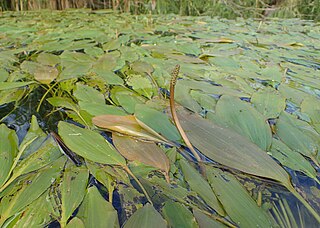
Potamogeton nodosus is a species of aquatic plant known by the common names longleaf pondweed and Loddon pondweed. It is native to Eurasia and the Americas, where it is widespread and can be found in water bodies such as ponds, lakes, ditches, and streams. This is a perennial herb producing a thin, branching stem easily exceeding a meter in maximum length. The submerged leaves are linear to widely lance-shaped and up to 15 by 4 centimetres in length and width, respectively, while the floating leaves achieve shorter maximum lengths and are ovate or elliptic. Both floating leaves and submerged leaves are borne on long petioles, a distinguishing characteristic. The inflorescence is a spike of many small flowers arising from the water on a peduncle.

Mipus is a genus of sea snails, marine gastropod mollusks in the subfamily Coralliophilinae of the family Muricidae, the murex snails or rock snails.
Cambarus nodosus is a species of crayfish in the family Cambaridae. It is found in North America.

Phoresis or phoresy is a temporary commensalistic relationship when an organism attaches itself to a host organism solely for travel. It has been seen in ticks and mites since the 18th century, and in fossils 320 million years old. It is not restricted to arthropods or animals; plants with seeds that disperse by attaching themselves to animals are also considered to be phoretic.

Nodipecten nodosus, or the lion's paw scallop, is a species of bivalve mollusc in the family Pectinidae. It can be found along the Atlantic coast of North America, ranging from Cape Hatteras to the West Indies, including Brazil and Bermuda.
Streptomyces nodosus is a bacterial species in the genus Streptomyces.

Chernetidae is a family of pseudoscorpions, first described by Anton Menge in 1855.

Lamprochernes chyzeri, also known as Chyzer’s shining claw, is a species of pseudoscorpion in the family Chernetidae. Its range covers most of Europe, including Sweden, Finland, Norway, England, Hungary, Romania and Yugoslavia. It is a phoretic passenger of the housefly.

Lamprochernes is a genus of pseudoscorpions in the family Chernetidae.













